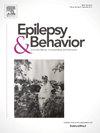Prescription patterns relevant to young people with epilepsy of childbearing potential
IF 2.3
3区 医学
Q2 BEHAVIORAL SCIENCES
引用次数: 0
Abstract
Rationale.
Young people with epilepsy of childbearing potential (YPWECP) are vulnerable to a variety of adverse health outcomes due to teratogenic antiseizure medications (ASMs) and drug-drug interactions between ASMs and contraceptives that can lead to breakthrough seizures and/or contraceptive failure. To better understand reproductive healthcare provision for YPWECP, we conducted a retrospective analysis of relevant prescription patterns.
Methods
We analyzed procedural and medication data for YPWECP ages 13–21 years (n = 1525) from 2011 through 2021 at a single tertiary-care pediatric medical center to investigate rates of (1) prescription of folic acid, (2) prescription of an enzyme-inducing ASM<6 months before or after hormonal contraception initiation (or < 3 years after subdermal implant placement), (3) prescription of lamotrigine < 6 months before or after an estrogen-containing contraceptive that could affect lamotrigine serum concentrations, and (4) documentation of any contraceptive medication or device that overlaps initiation of a patient’s first teratogenic ASM. We performed statistical analyses with sample proportion z-tests. We then used logistic regression and generalized estimating equations to evaluate for associations between patient characteristics and prescription patterns.
Results
Among 1525 YPWECP, less than half (41 %, n = 629) were prescribed folic acid during the study period (95 % CI 38.8–43.7). Of YPWECP prescribed an enzyme-inducing ASM, 24 % (186/766) were co-prescribed a hormonal contraceptive that adversely interacts with the ASM (95 % CI 21.2–27.3 %). Of those prescribed lamotrigine during the study period, 24 % (111/472) had documentation of an estrogen-containing medication that could affect lamotrigine serum concentrations < 6 months before or after that prescription (95 % CI 19.7–27.3 %). Of those prescribed a teratogenic ASM, only 13 % (82/638) had documentation of contraception prior to (or within the same month as) starting their first teratogenic ASM (95 % CI 10.3–15.5 %). Older age was associated with increased odds of contraceptive coverage prior to initiation of the first teratogenic ASM and was also associated with increased odds of having contraceptives co-prescribed with ASMs that could interact. No significant associations were found between race/ethnicity and any outcomes.
Conclusions
YPWECP experience low rates of folic acid prescription and low rates of contraceptive coverage while prescribed teratogenic ASMs. Many YPWECP, particularly older adolescents, are at increased risk for contraceptive failure and/or breakthrough seizures due to drug-drug interactions. Results demonstrate a need for increased focus on reproductive healthcare for YPWECP. Future studies should evaluate interventions aimed at improving these outcomes.
与有生育能力的青少年癫痫患者相关的处方模式。
理由:由于致畸抗癫痫药物(ASM)以及 ASM 与避孕药物之间的药物相互作用可能导致癫痫突破性发作和/或避孕失败,因此育龄癫痫患者(YPWECP)很容易出现各种不良健康后果。为了更好地了解为青年妇女和儿童提供的生殖保健服务,我们对相关处方模式进行了回顾性分析:方法:我们分析了一家三级儿科医疗中心从 2011 年到 2021 年为 13 至 21 岁的青壮年女性儿童提供的手术和用药数据(n = 1525),以调查(1)叶酸处方率;(2)酶诱导 ASM 处方率:在研究期间,1525 名青少年儿童中,不到一半(41%,n = 629)的人服用了叶酸(95 % CI 38.8-43.7)。在开具酶诱导 ASM 处方的青年妇女和儿童中,24%(186/766)的人同时开具了与 ASM 有不良相互作用的激素避孕药(95 % CI 21.2-27.3%)。在研究期间开具拉莫三嗪处方的患者中,24%(111/472)的患者有文件证明曾服用过可能会影响拉莫三嗪血清浓度的含雌激素药物:青年妇女和儿童在服用致畸 ASM 时,叶酸处方率和避孕覆盖率都很低。由于药物之间的相互作用,许多青少年妇女和儿童,尤其是年龄较大的青少年,避孕失败和/或突破性癫痫发作的风险增加。研究结果表明,有必要加强对青少年女性和儿童生殖保健的关注。未来的研究应评估旨在改善这些结果的干预措施。
本文章由计算机程序翻译,如有差异,请以英文原文为准。
求助全文
约1分钟内获得全文
求助全文
来源期刊

Epilepsy & Behavior
医学-行为科学
CiteScore
5.40
自引率
15.40%
发文量
385
审稿时长
43 days
期刊介绍:
Epilepsy & Behavior is the fastest-growing international journal uniquely devoted to the rapid dissemination of the most current information available on the behavioral aspects of seizures and epilepsy.
Epilepsy & Behavior presents original peer-reviewed articles based on laboratory and clinical research. Topics are drawn from a variety of fields, including clinical neurology, neurosurgery, neuropsychiatry, neuropsychology, neurophysiology, neuropharmacology, and neuroimaging.
From September 2012 Epilepsy & Behavior stopped accepting Case Reports for publication in the journal. From this date authors who submit to Epilepsy & Behavior will be offered a transfer or asked to resubmit their Case Reports to its new sister journal, Epilepsy & Behavior Case Reports.
 求助内容:
求助内容: 应助结果提醒方式:
应助结果提醒方式:


